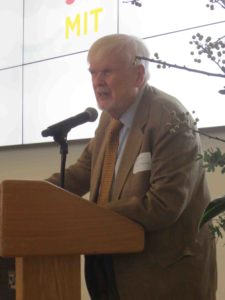On a crisp autumn evening punctuated by a postcard-worthy sunset, MIT’s Knight Science Journalism Program honored its founder, launched a new science journalism award, and celebrated 35 years as one of journalism’s preeminent fellowship programs.
Some one hundred attendees — including current and former fellows, current director Deborah Blum, and three of the program’s previous directors — mixed and mingled at the Media Lab’s Silverman Skyline Room last Sunday. Victor McElheny, the program’s founder and inaugural director, was the evening’s guest of honor and keynote speaker.
In his remarks, McElheny recounted the program’s origin story, recalling MIT as a natural venue to host “journalists who had grown to love describing technical matters in everyday language and vivid images and sound.” Then as now, McElheny said, the aim was for proven, ambitious science journalists to “spend a year building their skills, contacts, and confidence for a long future of intense, even wild change.”

McElheny launched the fellowship program in 1983 — after successfully garnering foundation support — and notably gained a major endowment from the John S. and James L. Knight Foundation. Over the three and a half decades of its existence, the Knight Science Journalism Program has hosted more than 300 mid-career science journalists representing nearly 40 countries and six continents.
“The headline tonight is that Victor built something that has lasted — and that’s hard to do,” said MIT Vice President of Communications Nate Nickerson in his introductory remarks.
Also speaking at the event was Paula Apsell, Senior Executive Producer of NOVA and a member of the program’s first fellowship class. She described her fellowship experience as a life-changing one that shaped her science storytelling in the years that followed.
The Knight Science Journalism program continues to flourish in its 35th year, with a class that includes reporters and editors from the Los Angeles Times, the Associated Press, and other venerable publications. And on Sunday, the program announced a new endeavor: The event marked the launch of the Victor K. McElheny Award, which will honor outstanding coverage of science, public-health, technology, or environmental issues at the local or regional level.
“That future generations will associate the name Victor K. McElheny with excellence in science journalism makes me – and all of MIT – extremely proud,” wrote MIT President Rafael Reif, in a letter presented during the ceremony.
At a time when local journalism—especially local science journalism—is on the wane, McElheny says he hopes the new award will spark renewed focus on front-line discoveries and their impacts on our everyday lives. “We can think of this prize as an encouragement to one of our most precious attributes: curiosity.”
Blum closed the event by asking all fellows, past and present, to stand. She noted how important all of them were in changing and improving the profession of science journalism — and heralded the accomplishments to come. Leading the room in a round of applause, she said to the assembled fellows: “We are so proud of all of you.”





Leave a Reply